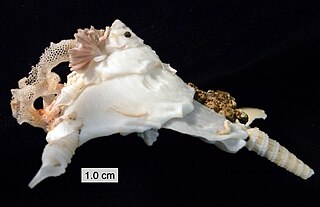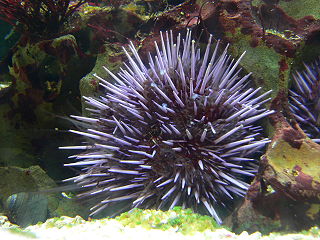Neomphalidae is a family of sea snails or limpets, specifically deep sea hydrothermal vent limpets. This family was included in the Vetigastropoda, which is a clade according to the Bouchet & Rocroi, 2005. It is now included in the clade Neomphalina.

The Trochidae, common name top-snails or top-shells, are a taxonomic family of very small to large sea snails, marine gastropod molluscs in the clade Vetigastropoda.

Xenophoridae, commonly called carrier shells, is a family of medium-sized to large sea snails, marine gastropod mollusks in the clade Littorinimorpha.

Lottiidae is a family of sea snails, specifically true limpets, marine gastropod mollusks in the superfamily Lottioidea and the clade Patellogastropoda.
The World Register of Marine Species (WoRMS) is a taxonomic database that aims to provide an authoritative and comprehensive list of names of marine organisms.

Strongylocentrotus is a genus of sea urchins in the family Strongylocentrotidae containing several species.

The Echinacea are a superorder of sea urchins. They are distinguished by the presence of a rigid test, with ten buccal plates around the mouth, and solid spines. Unlike some other sea urchins, they also possess gills. The group is a large one, with species found worldwide.
Aspidodiadema jacobyi is a small sea urchin in the family Aspidodiadematidae. It lives in tropical seas at great depths. Aspidodiadema jacobyi was first scientifically described in 1880 by Alexander Emanuel Agassiz, an American scientist.
Aspidodiadema africanum is a species of sea urchin of the family Aspidodiadematidae. Their armour is covered with spines. It is placed in the genus Aspidodiadema and lives in the sea. Aspidodiadema africanum was first scientifically described in 1939 by Ole Theodor Jensen Mortensen, a Danish scientist.

Aspidodiadema arcitum is a species of sea urchin of the family Aspidodiadematidae. Their armour is covered with spines. It is placed in the genus Aspidodiadema and lives in the sea. Aspidodiadema arcitum was first scientifically described in 1939 by Ole Theodor Jensen Mortensen, a Danish scientist.

Aspidodiadema hawaiiense is a species of sea urchin of the family Aspidodiadematidae. Their armor is covered with spines. It is placed in the genus Aspidodiadema and lives in the sea. Aspidodiadema hawaiiense was first scientifically described in 1939 by Ole Theodor Jensen Mortensen, a Danish scientist.
Aspidodiadema intermedium is a species of sea urchin of the family Aspidodiadematidae. Their armour is covered with spines. It is placed in the genus Aspidodiadema and lives in the sea. Aspidodiadema intermedium was first scientifically described in 1977 by Shigei.
Aspidodiadema meijerei is a species of sea urchin of the family Aspidodiadematidae. Its armor is covered with spines. It is placed in the genus Aspidodiadema and lives in the sea. Aspidodiadema meijerei was first scientifically described in 1906 by Döderlein.
Aspidodiadema montanum is a species of sea urchin of the family Aspidodiadematidae. Their armour is covered with spines. It is placed in the genus Aspidodiadema and lives in the sea. Aspidodiadema montanum was first scientifically described in 1981 by Mironov.
Aspidodiadema sinuosum is a species of sea urchin of the family Aspidodiadematidae. Their armour is covered with spines. It is placed in the genus Aspidodiadema and lives in the sea. Aspidodiadema sinuosum was first scientifically described in 1981 by Mironov.
Aspidodiadema tonsum is a species of sea urchin of the family Aspidodiadematidae. Their armour is covered with spines. It is placed in the genus Aspidodiadema and lives in the sea. Aspidodiadema tonsum was first scientifically described in 1879 by Alexander Emanuel Agassiz.

Eucidaris is a genus of cidaroid sea urchins known as slate pencil urchins. They are characterised by a moderately thick test, a usually monocyclic apical disc, perforate and non-crenulate tubercles and nearly straight ambulacra with horizontal pore pairs. The primary spines are few and widely spaced, stout with blunt flat tips and beaded ornamentation and the secondary spines are short and apressed. They originated in the Miocene and extant members of the genus are found in the tropical Indo-Pacific Ocean, East Pacific, Atlantic Ocean and Caribbean Sea.

Synallactida is a rankless clade of sea cucumbers, but is referred to as an order. Taxa within Synallactida were previously classified in an order called Aspidochirotida, which was determined to be polyphyletic in 2017.

Clypeasteridae is a family of sea urchins in the order Clypeasteroida. This family was first scientifically described in 1835 by the Swiss-American biologist Louis Agassiz.

Mellitidae is a family of sand dollars, in the echinoderm order Clypeasteroida. These irregular sea urchins bury themselves in soft sediment in shallow seas.











